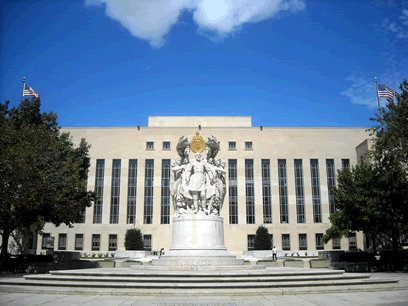Courthouse Steps: D.C. Circuit En Banc Argument - Podcast
Federalism & Separation of Powers Practice Group Podcast

The D.C. Circuit heard a rare doubleheader of en banc arguments on major structural separation of powers questions on May 24.
First up was Raymond J. Lucia Companies, Inc. v. SEC, which presented the question whether Administrative Law Judges at the SEC are “Officers of the United States” who must be selected in compliance with the Appointments Clause. The SEC contends that its ALJs are employees, not officers, because the ALJs do not exercise “significant authority pursuant to the laws of the United States,” which the Supreme Court has described as the hallmark of officer status. Last August, a three-judge panel of the D.C. Circuit agreed with the SEC, relying almost exclusively on an earlier (divided) D.C. Circuit precedent, Landry v. FDIC, 204 F.3d 1125 (D.C. Cir. 2000), which held the ALJs at the FDIC are not officers because they do not issue final agency decisions. Three months later, the Tenth Circuit issued a 2-1 decision finding that SEC ALJs are officers who must be selected pursuant to the Appointments Clause. The Tenth Circuit panel expressly disagreed with Lucia and Landry that authority to issue final agency decisions is a prerequisite for officer status. The D.C. Circuit subsequently vacated its panel decision and granted en banc review. The status of ALJs under the Appointments Clause has important implications not only for the SEC’s enforcement of the securities laws but also for the system of administrative agency adjudication as a whole.
The second case, PHH Corp. v. CFPB, presented the question whether an “independent” administrative agency may be led by a single person. In a 100-page opinion by Judge Kavanaugh (joined by Judge Randolph) drawing on historical practice and first principles of separation of powers, the panel concluded that the statutory provision vesting the CFPB’s broad enforcement authority in a single director removable by the President only “for cause” violated Article II of the Constitution. The panel emphasized the absence of any historical precedent for an independent agency with a single director—a structure that created, in the panel’s description, an administrative official with more power than anyone in the federal government other than the President. The panel explained that this concentration of authority in a single person unaccountable to the President except for cause posed a “threat to individual liberty.” The panel remedied the constitutional defect by severing the statute’s “for cause” removal provision, thus making the CFPB director removable by the President at will. Judge Henderson dissented in part, arguing that the panel could have resolved the case on the basis of PHH’s statutory rather than constitutional challenges. The D.C. Circuit granted en banc review on both the constitutional and statutory questions. The Justice Department (under the Trump Administration) filed an amicus brief in support of the challengers, while the CFPB continues to defend the constitutionality of its structure through its independent litigation authority.
Featuring:
- Thaya Brook Knight, Associate Director of Financial Regulation Studies, Cato Institute
- Christopher G. Michel, Associate, Bancroft PLLC






